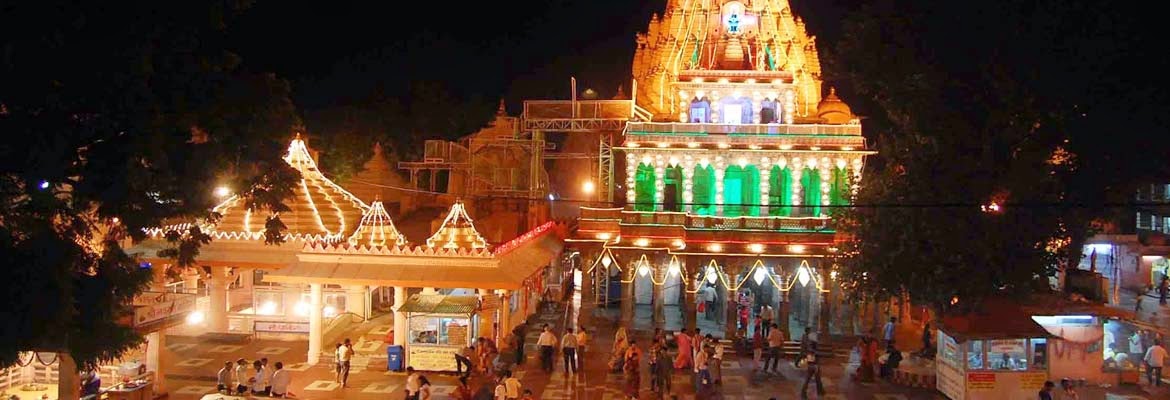Lord Shiva manifested in the form of Jyotirlingam or the cosmic light.
Kedarnath is highest among the 12 Jyotirlingas. This ancient and
magnificient temple is located in the Rudra Himalaya range. This temple,
over a thousand years old is built of massive stone slabs over a large
rectangular platform. Ascending through the large gray steps leading to
the holy sanctums we find inscriptions in Pali on the steps. The present
temple was built by Adi Shankaracharya.The inner walls of the temple
sanctum are adorned with figures of various deities and scenes from
mythology. The origin of the revered temple can be found in the great
epic - Mahabharata. According to legends, the Pandavas sought the
blessings of lord Shiva to atone their sin after the battle of
Mahabharata. Lord Shiva eluded them repeatedly and while fleeing took
refuge at Kedarnath in the form of a bull. On being followed, he dived
into ground leaving behind his hump on the surface. Outside the temple
door a large statue of the Nandi Bull stands as guard. A conical rock
formation inside the temple is worshipped as Lord Shiva in his Sadashiva
form. The temple, believed to be very ancient, has been continually
renovated over the centuries. It is situated at an altitude of 3,581 mt.
It is a 21 km trek from Sonprayag. At the approach of winters in the month of November, the holy statue of
Lord Shiva, is carried down from Kedarnath to Ukhimath, and is
reinstated at Kedarnath, in the first week of May. It is at this time,
that the doors of the temple are thrown open to pilgrims, who flock from
all parts of India, for a holy pilgrimage. The shrine closes on the
first day of Kartik (Oct-Nov) and reopens in Vaishakh (Apr-May) every
year. During its closure the shrine is submerged in snow and worship is
performed at Ukhimath.
Location
Kedarnath is amongst the holiest pilgrimages for the devout Hindu. It
is set amidst the stunning mountainscape of the Garhwal Himalayas at the
head of the Mandakini River. Kedar is another name of lord Shiva, the
protector and the destroyer. Shiva is considered the embodiment of all
passions - love, hatred, fear, death and mysticism which are expressed
through his various forms.
The shrine of Kedarnath is very scenically placed, and is surrounded by
lofty, snow - covered mountains, and during summer grassy meadows
covering the valleys. Immediately behind the temple, is the high
Keadardome peak, which can be sighted from great distances. The sight of
the temple and the peak with its perpetual snows is simply enthralling.
The Mythological Past
There are more than 200 shrines dedicated to Lord Shiva in Chamoli
district itself, the most important one is Kedarnath. According to
legend, the Pandavas after having won over the Kauravas in the
Kurukshetra war, felt guilty of having killed their own Kith and Kin and
sought the blessings of Lord Shiva for redemption. He eluded them
repeatedly and while fleeing took refuge at Kedarnath in the form of a
bull.
On being followed he dived into the ground, leaving his hump on the
surface. The remaining portions of Lord Shiva appeared at four other
places and are worshipped there as his manifestations.
The arms appeared at Tungnath, the face at Rudranath, the belly at
Madmaheshwar and his locks (hair) with head at Kalpeshwar. Kedarnath and
the four above mentioned shrines are treated as Panch Kedar.
An imposing sight, standing in the middle of a wide plateau surrounded
by lofty snow covered peaks. The present temple, built in 8th century
A.D. by Adi Shankaracharya, stands adjacent to the site of an earlier
temple built by the Pandavas. The inner walls of the assembly hall are
decorated with figures of various deities and scenes from mythology.
Outside the temple door a large statue of the Nandi Bull stands as
guard.
Dedicated to Lord Shiva, the exquisitely architectured Kedarnath temple
is considered to be more than 1000 years old. Built of extremely large,
heavy and evenly cut grey slabs of stones, it evokes wonder as to how
these heavy slabs had been handled in the earlier days. The temple has a
Garbha Griha for worship and a Mandap, apt for assemblies of pilgrims
and visitors. A conical rock formation inside the temple is worshipped
as Lord Shiva in his Sadashiva form.
Best Time to visit:-
The ideal time or peak season to go for a Char Dham Yatra is from May
to October, except monsoons. This is because; all the four sacred sites
are perched in Garhwal Himalayas, which is prone to heavy snowfall. As a
result, all the passage leading to the shrines are blocked. Moreover,
during the monsoon season, there is undue threat of having landslides,
which can further disrupt the journey.
Kapat Opening:- The kapat of Shri Kedarnath Temple was opened on 04th May 2014 at 6:00 AM.
GETTING THERE
Air : Nearest airport is Jolly Grant, 260 kms.
Rail : Nearest railhead is at Rishikesh, 243 kms.
Road : Well connected to Rishikesh, Haridwar, Dehradun and Delhi.

























